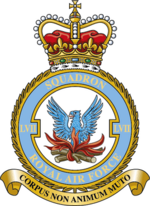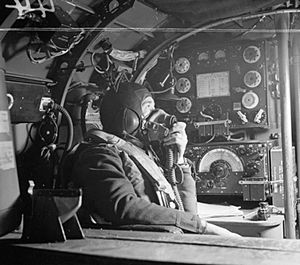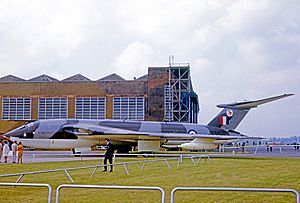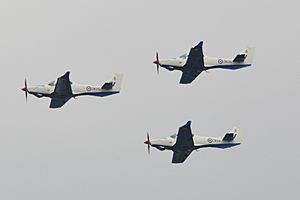No. 57 Squadron RAF facts for kids
Quick facts for kids No. 57 Squadron RAF |
|
|---|---|

Squadron badge
|
|
| Active | 8 June 1916 – 1 April 1918 (RFC) 1 April 1918 – 31 December 1919 (RAF) 20 October 1931 – 25 November 1945 26 November 1945 – 9 December 1957 1 January 1959 – 30 June 1986 1 July 1992 – 14 March 2002 1 October 2008 – present |
| Country | |
| Branch | |
| Type | Flying squadron |
| Role | Elementary Flying Training |
| Part of | No. 3 Flying Training School |
| Home station | RAF Cranwell |
| Motto(s) | Corpus non animum muto (Latin for 'I change my body not my spirit') |
| Aircraft | Grob Prefect T1 |
| Battle honours |
|
| Insignia | |
| Squadron badge heraldry | Issuant from two logs fesse-wise in saltire a phoenix, commemorating that on one occasion during the First World War the whole of the flying personnel became casualties within a few days, but the squadron remained in action with new personnel. Approved by King George VI in December 1936. |
| Squadron codes | EQ (Nov 1938 – Sep 1939) DX (Apr 1940 – Apr 1951) QT (1944 – Nov 1945, 'C' Flt) |
No. 57 Squadron, also known as No. LVII Squadron, is a special flying training group in the Royal Air Force. They fly the Grob Prefect T1 aircraft from RAF Cranwell in Lincolnshire, UK. Their main job is to teach new pilots how to fly.
Contents
History of No. 57 Squadron
Early Days: World War I
No. 57 Squadron started on June 8, 1916, during World War I. It was part of the Royal Flying Corps. At first, they trained pilots using planes like the Avro 504 and Royal Aircraft Factory B.E.2.
In late 1916, they changed their role to fighter-reconnaissance. This meant they would fly planes to scout out enemy positions and sometimes fight. They used Royal Aircraft Factory F.E.2 planes. In December 1916, they moved to France to join the war effort.
By April 1917, their planes were getting old. The squadron faced tough battles, especially during the British offensive at Arras. They lost many planes and pilots.
In May 1917, they got new, faster planes called Airco DH.4s. Their job changed to long-range bombing and scouting. They helped in big battles like the Ypres Offensive. They bombed railway lines and enemy airfields.
During the German attacks in 1918, the squadron bombed targets to slow down the enemy. They also supported the Allied attacks that helped end the war. Some pilots in the squadron became "flying aces," meaning they shot down many enemy aircraft. Overall, they claimed 166 German planes and dropped a lot of bombs.
After the war ended in November 1918, the squadron helped carry mail. They returned to the UK in August 1919 and were officially stopped on December 31, 1919.
Between the World Wars
The squadron started up again on October 20, 1931, at RAF Netheravon. They flew Hawker Hart light bomber planes. They moved to RAF Upper Heyford in 1932.
No. 57 Squadron often took part in big air shows, showing off their flying skills. They also participated in a special review of the RAF by King George V in 1935. In 1936, they upgraded to Hawker Hind planes.
Later, in 1938, they got Bristol Blenheim Mk I twin-engine bombers. They trained for missions against ships and for supporting ground troops.
World War II Missions

When World War II began in September 1939, the squadron moved to France. They flew reconnaissance missions, which means they flew to gather information about enemy forces.
During the German invasion of France in May 1940, they also started bombing missions. They had to move bases often to avoid the advancing German army. Eventually, they returned to England. After that, they were sent to Scotland to attack German ships off the coast of Norway.
In November 1940, the squadron moved to RAF Feltwell and started using Vickers Wellington medium bombers. In September 1942, they moved to RAF Scampton and switched to Avro Lancaster heavy bombers. These were powerful planes used for large bombing raids.
From August 1943 until the end of the war, they operated from RAF East Kirkby. During the war, No. 57 Squadron flew over 5,000 missions and lost 172 aircraft. They were officially stopped again on November 25, 1945.
Cold War Era: Bombers and Tankers
The squadron was reformed the very next day, November 26, 1945, at RAF Elsham Wolds. They flew Avro Lincoln bombers. They moved around to different RAF bases over the next few years.
In 1951, they started flying the Boeing Washington B.1 aircraft. These were large American bombers. In 1953, they switched to the English Electric Canberra B.2, which was a fast jet bomber. The squadron was stopped again on December 9, 1957.

No. 57 Squadron started up once more on January 1, 1959. They became part of the "V bomber" force, flying the Handley Page Victor B.1. These planes were designed to carry nuclear weapons as a deterrent during the Cold War.
In 1965, their role changed. They became a "tanker squadron" with the Victor K.1. This meant their planes were used to refuel other aircraft in the air, allowing them to fly longer missions. In 1976, they upgraded to the Victor K.2.
In 1982, when Argentina invaded the Falkland Islands, No. 57 Squadron played a key role. They deployed to Ascension Island and supported the famous Operation Black Buck raids. These were very long-range bombing missions carried out by Avro Vulcan bombers against Port Stanley Airport. The Victor tankers refueled the Vulcans many times during these missions.
The squadron was stopped again on June 30, 1986. This was partly because the Falklands War missions used up a lot of the Victor fleet's remaining flying hours.
Training Pilots Today
The squadron number was used again on June 1, 1992, for a training unit. This unit taught pilots how to fly the Lockheed C-130 Hercules transport plane. They continued this role until March 14, 2002, when the squadron was stopped.
On October 1, 2008, No. 57 Squadron was reformed once more. This time, it became an Elementary Flying Training squadron. They started teaching new pilots using the Grob Tutor T.1 aircraft at RAF Wyton.
In 2014, the squadron moved to RAF Cranwell. Since February 2018, it has been known simply as No. 57 Squadron (the "Reserve" part was removed). In 2018, they upgraded to the Grob Prefect T.1.
Today, No. 57 Squadron is part of the UK Military Flying Training System. They give student pilots from all three military services (Royal Air Force, Royal Navy, and British Army) their first 20 hours of flight training. After this, pilots are chosen for different types of flying, like fast jets, helicopters, or large multi-engine planes.
Aircraft Flown by the Squadron
This table shows the different types of aircraft that No. 57 Squadron has flown throughout its history.
| Dates | Aircraft | Variant | Notes |
|---|---|---|---|
| 1916 | Royal Aircraft Factory B.E.2 | BE2c | |
| 1916 | Avro 504 | 504K | |
| 1916–1917 | Royal Aircraft Factory F.E.2 | FE2d | |
| 1917–1919 | Airco DH.4 | ||
| 1919 | de Havilland DH.9 | DH.9A | |
| 1931–1936 | Hawker Hart | ||
| 1936–1938 | Hawker Hind | ||
| 1938–1940 | Bristol Blenheim | I | |
| 1940 | Bristol Blenheim | IV | |
| 1940–1942 | Vickers Wellington | IA, IC, II and III | |
| 1942–1946 | Avro Lancaster | I & III | |
| 1945–1951 | Avro Lincoln | B2 | |
| 1951–1953 | Boeing Washington | B1 | |
| 1953–1957 | English Electric Canberra | B2 | |
| 1959–1966 | Handley Page Victor | B1 | |
| 1966–1977 | Handley Page Victor | K1 | |
| 1976–1986 | Handley Page Victor | K2 | |
| 1992–2002 | Lockheed C-130 Hercules | ||
| 2008–2018 | Grob Tutor | T1 | |
| 2018–present | Grob Prefect | T1 |
See also
- Alfie Fripp, longest serving and last surviving British prisoner of war
- List of Royal Air Force aircraft squadrons
Endnotes
Images for kids
-
No. 57 Squadron Avro Lancaster with "Usual" area bombing load of 4000 pound "blockbuster" bomb and incendiary bombs



